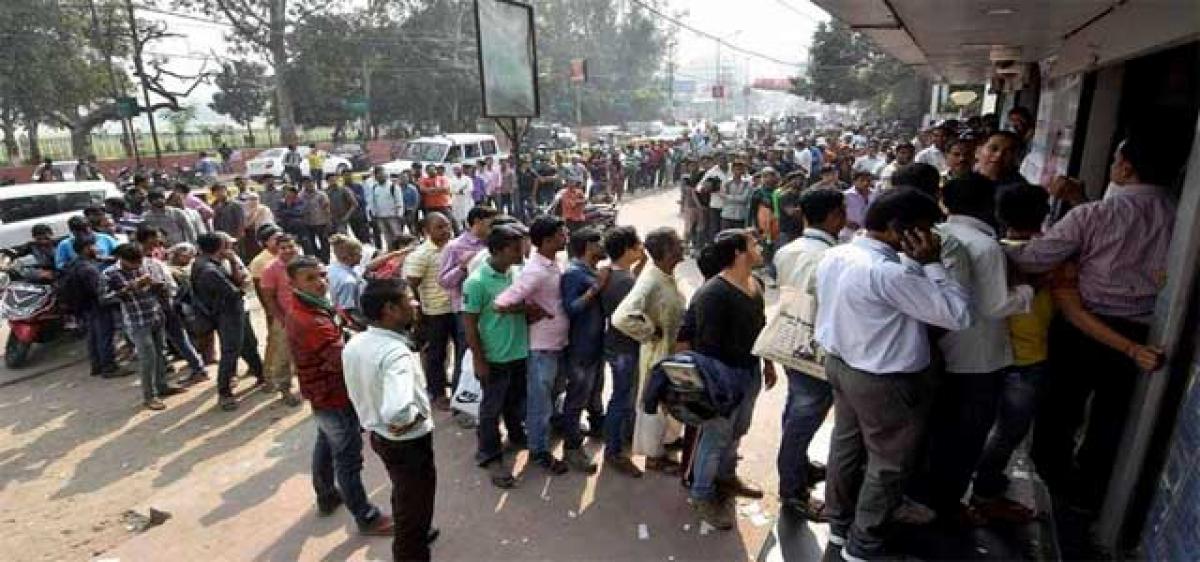Live
- BJP MP candidate Bharat Prasad visited the student who tried to commit suicide
- PM’s popularity in the fast lane: Autos with 'Har Dil Mein Modi' slogan spotted across Delhi
- Delhi-based political parties are like East India Company: Sukhbir Badal
- Golf: Diksha moves into Top-20 at South African Women’s Open
- KCR lashes out against BJP and Congress for destroying Telangana
- Dairy Science students visited the Milk cooling plant
- Moody feels Pant ahead in keepers’ race for T20 WC squad; Srikkanth picks Rahul over Samson as reserve keeper
- Thanking voters for extending 'unparalleled support' to NDA, PM Modi says second phase 'too good'
- Natural Relief for Menstrual Cramps: Beetroot Juice Recipe
- Asha Worker died in a road accident
Just In

In exactly a week, the Narendra Modi government will unveil its plans and measures to revitalise economy in the new fiscal as the current one is witnessing all-round slowdown.
In exactly a week, the Narendra Modi government will unveil its plans and measures to revitalise economy in the new fiscal as the current one is witnessing all-round slowdown.
Recessionary trends coupled with unprecedented demonetisation have served a double whammy for the economy. The note ban particularly dealt a body blow to consumer spending, hitting hard livelihoods in informal sectors.
The agriculture sector which came to the rescue of economy, despite back-to-back drought years, is reeling due to the enervating note ban exercise. Recall that the GDP could rise to 7.3 per cent in the second quarter from 7.1 per cent in the previous quarter on the back of a strong revival in agriculture sector.
If agriculture could buck the trend of decline on its own, imagine what government support would do to such a resilient sector.
The sector which grew only 0.2% and 1.2% in 2014 and 2015 respectively was forecast to expand by about 4 per cent this fiscal, due to an ‘above normal’ monsoon. GDP was being expected to touch 8 per cent by fiscal-end by some.
Alas, the rude note ban shock came as farmers were busy harvesting kharif crop and preparing for rabi crops. Most of payments in agriculture sector are cash-based. Reports say the measure nearly broke the backbone of rural economy.
Other sectors, too, like MSMEs, construction, textiles and small businesses etc took a hard hit. For them in rural areas, the demand germinates in the farm sector.
Having cast aside the crisis as a temporary pain for a long-term gain, the Centre cannot but budget for strong incentives to turn around agriculture which sustains over half the population. Its dependent sectors take care of another 10 per cent.
It is time the Modi government devised ways to prevent agriculture from remaining hostage to monsoons and paltry MSPs. The green revolution of 1960s and 1970s addressed chronic food shortages and India could become second largest global agri producer after China.
However, now it ranks 97 among 118 countries on the 2016 Global Hunger Index. The need is not just food security but nutrition security to all Indians. The around 5 million tonnes pulses imports need to be substituted by more domestic production.
A study in 2013 put annual harvest and post-harvest losses at around Rs 93,000 crore. The wastages shall be curbed. No less is restoration of seeds sovereignty to farmers.
It must be lauded that the Modi government, targeting doubling of farmers income by 2022, hiked agri allocation by 84% to nearly Rs 48,000 crore this fiscal. But the ground effect is no better than last fiscal’s.
In a nutshell, the government must heed the recommendations of Prof MS Swaminathan Commission to turn around agriculture and thereby ensure uptick in consumer spending to spur the formal sectors. Else, jobs are not only hard to come by, but there would be loss of livelihoods on a large-scale.
A robust agriculture is imperative when private investment as well as government consumption cannot ward off downtrend in economy, as has been cautioned by IMF, CSO, RBI and various research bodies. Indeed, it is time for new green revolution.

© 2024 Hyderabad Media House Limited/The Hans India. All rights reserved. Powered by hocalwire.com







